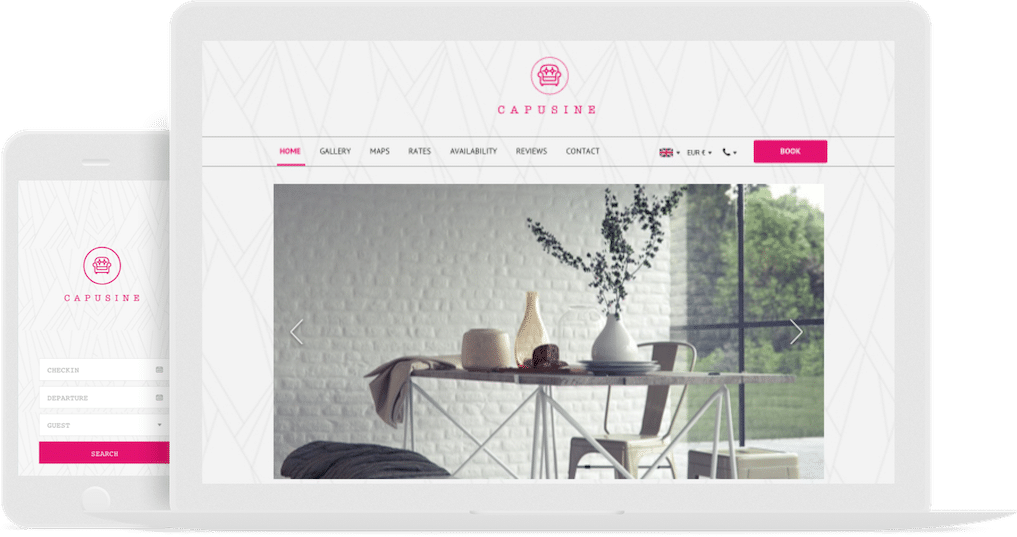There are simply too many vacation rental owners out there who are still trying to get by and make waves in a competitive market with a website that is just not doing the trick! When did you last you step back and really scrutinize your site? Could it be time for an update?
We reveal the seven sure-fire signs that indicate you should revamp your vacation rental website to get back in the game!
1. It’s not responsive
It’s official: more than half of all travel trips taken in 2016 will have been booked on cell phones, so if your vacation rental website isn’t mobile-friendly, you could be missing out on a lot of bookings.
Unsure whether your site is responsive or not? Plug your URL into Google’s free mobile-friendly testing tool and find out.
You don’t need to be a computer wizard to create a mobile-responsive website, there are plenty of vacation rental software options out there which can provide you with a ready-made template that will adapt your site to mobile and tablet screens, keeping you out of trouble with Google’s strict mobile criteria.
2. You can’t accept secure payments
If your vacation rental website can’t accept bookings, but you’re still taking cash or check payments upon guest arrival or asking for bank transfers, your potential renters may not instill a whole load of trust in your site in terms of whether it’s legitimate (or not!).
A simple booking system that allows you to accept secure, online payments (e.g. by credit card) will not only modernize your website in an instant, it will also help your credibility as a vacation rental business.
Not only are credit cards the preferred payment method by most younger renters, but these types of payments also provide tons of benefits for owners and guests alike – especially when it comes to online security, fraud prevention and convenience.
3. It’s not visually attractive
Take a step back from your website, put yourself in your guests’ shoes and reopen the page: does your website really make you want to book your vacation rental?
If the answer is no, that means it’s time for a makeover.
There are plenty of dos and don’ts when it comes to vacation rental web design, but first things first, you want a beautiful site that will entice your potential guests and attract them into staying at your home.
That means high quality photos, a complimentary color scheme, easy navigation and an overall good user experience. Without these, no visitor is going to look past the homepage.
4. You need a degree in computer science to make an update
Modern website building needn’t be complicated, nor should it require extra hands to update simple information like your contact details.
If your vacation rental website provider is outdated and it’s difficult to make even the smallest changes, consider switching to a website builder that’s intuitive and understands not all of its users are developers with years of experience…
Whether you build your own site using templates like Lodgify’s, or another provider such as WordPress or Wix, you’ll be given access to your website’s CMS (content management system) and backend which will allow you to make whatever updates you need, as easily and quickly as you like.
5. Guests can’t contact you about inquiries
Are your contact details readily available on each of your website pages? Do you have an easy-to-use contact form? Because without these features, you can’t expect to receive any inquiries at all.
As well as deciding on a vacation rental because it ticks the boxes of location, price and amenities, guests want to get to know their owner personally before making their booking. It’s likely your guests are looking at (and making inquiries for) multiple rentals in your area, so don’t let your competition have the upper hand.
Even if you simply set up your inbox to send out a friendly autoresponder message when you receive an inquiry, this can rev your customer service up a gear and make an interested guest remember your property over a competitor’s.
6. It takes forever to load
Research shows that over 50% of internet users admit to abandoning a website if it takes longer than three seconds to load. Do you really want your site to be added to potential guests’ blacklists of outdated, poor-functioning websites?
There are lots of ways to optimize your site for faster load times, which we won’t bore you with here, especially as many top providers already do the hard work for you. Just know that having a speedy website can make all the difference for the guest who’s flicking between various options and trying to work out which vacation rental suits them best!
7. You’re not taking bookings
Wait, shouldn’t this have been point number one? Well not necessarily, since a lot of vacation rental owners depend on listing sites for their bookings, even though there are some downsides to doing so!
Your vacation rental website, and any listing sites you appear on, should complement one another. That said, your users should also be free to navigate independently to your personal website, and make their booking without incurring any of the extra fees or costs that Airbnb and HomeAway slap on.
If you can’t remember your last direct booking on your vacation rental website, it really is time to do something about it! To drive traffic (and bookings) to your site, you need to get acquainted with SEO, learn about other types of online marketingand familiarize yourself with social proof, then you’ll see the inquiries start rolling in.
Making sure your site is mobile-optimized, user-friendly, up-to-date and ready to accept bookings and payments is just the beginning. Start your free trial of Lodgify and see just how easily you can breathe life back into your site and your business!


